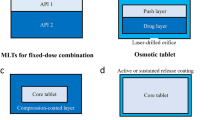Abstract
Bilayer tableting technology has gained popularity in recent times, as bilayer tablets offer several advantages over conventional tablets. There is a dearth of knowledge on the impact of material properties and process conditions on the performance of bilayer tablets. This paper takes a statistical approach to develop a model that will determine the effect of the material properties and bilayer compression process parameters on the bonding strength and mode of breakage of bilayer tablets. Experiments were carried out at pilot scale to simulate the commercial manufacturing conditions. As part of this endeavor, a seven-factor half-fraction factorial (27−1) design was executed to study the effect of bilayer tablet compression process factors on the bonding strength of bilayer tablets. Factors studied in this work include: material properties (plastic and brittle), layer ratio, dwell time, layer sequence, first- and second-layer forces, and lubricant concentration. Bilayer tablets manufactured in this study were tested using the axial tester, as it considers both the interfacial and individual layer bonding strengths. Responses of the experiments were analyzed using PROC GLM of SAS (SAS Institute Inc, Cary, North Carolina). A model was fit using all the responses to determine the significant interactions (p < 0.05). The results of this study indicated that nature of materials played a critical role on the strength of bilayer compacts and also on mode of fracture. Bilayer tablets made with brittle materials in both the layers are strongest, and fracture occurred in the first layer indicating that interface is stronger than layers. Significant interactions were observed between the selected factors and these results will provide an insight into the interplay of material properties, process parameters, and lubricant concentration on the bonding strength and mode of breakage of bilayer tablets.






Similar content being viewed by others
REFERENCES
LaForce C, Gentile DA, Skoner DP. A randomized, double-blind, parallel group, multicenter, placebo-controlled study of the safety and efficacy of extended-release guaifenesin/pseudoephedrine hydrochloride for symptom relief as an adjunctive therapy to antibiotic treatment of acute respiratory infections. Postgrad Med. 2008;120:53–9.
Li SP, Karth MG, Feld KM, DiPaolo LC, Pendharkar CM, Williams RO. Evaluation of bilayer tablet machines—a case study. Drug Dev and Ind Pharm. 1995;21:571–90.
Efentakis M, Peponaki C. Formulation study and evaluation of matrix and three-layer tablet sustained drug delivery systems based on carbopols with isosorbite mononitrate. AAPS PharmSciTech. 2008;9:917–23.
Verma RK, Garg S. Current status of drug delivery technologies and future directions. Pharm Tech. 2001;25:1–14.
Park CR, Munday DL. Development and evaluation of a biphasic buccal adhesive tablet for nicotine replacement therapy. Int J Pharm. 2002;237:215–26.
Abdul S, Poddar SS. A flexible technology for modified release of drugs: multi layered tablets. J Control Release. 2004;97:393–405.
Bangalore S, Kamalakkannan G, Parkar S, Messerli FH. Fixed-dose combinations improve medication compliance: a meta-analysis. Am J Med. 2007;120:713–9.
Inman SJ, Briscoe BJ, Pitt KG. Topographic characterization of cellulose bilayered tablets interfaces. Trans IchemE, Part A, Chem Eng Res Des. 2007;85:1005–12.
Wong PSL, Gupta SK, Stewart BE. Osmotically controlled tablets. In: Rathbone MJ, Hadgraft J, Roberts MS, editors. Modified-release drug delivery technology. London: Informa Healthcare; 2002. p. 101–14.
Dietrich P, Bauer-Brandl A, Schubert R. Influence of tableting forces and lubricant concentration on the adhesion strength in complex layer tablets. Drug Dev Ind Pharm. 2000;26:745–54.
Ozkan N, Briscoe B. The surface topography of compacted agglomerates; a means to optimize compaction conditions. Pow Tech. 1996;86:201–7.
Wu CY, Seville JPK. A comparative study of compaction properties of binary and layered tablets. Pow Tech. 2009;189:285–94.
Roberts RJ, Rowe RC. The young’s modulus of pharmaceutical materials. Int J Pharm. 1987;37:15–8.
Akseli I, Abebe A, Sprockel O, Cuitino AM. Mechanistic characterization of bilayer tablets. Pow. Tech. 2012 (in press).
Vaithiyalingam SR, Sayeed VA. Critical factors in manufacturing multilayer tablets—assessing material attributes, in-process controls, manufacturing process and product performance. Int J Pharm. 2010;398:9–13.
Podczeck F. Particle–particle adhesion in pharmaceutical powder handling. London: Imperial College Press; 1998. p. 150–2.
Tye CM, Sun C, Amidon GE. Evaluation of the effects of tableting speed on the relationships between compaction pressure, tablet tensile strength, and tablet solid fraction. J Pharm Sci. 2005;94:465–72.
Miller TA, York P. Pharmaceutical tablet lubrication. Int J Pharm. 1988;41:1–19.
Akseli I, Dey D, Cetinkaya C. Mechanical property characterization of bilayered tablets using nondestructive air-coupled acoustics. AAPS PharmSciTech. 2010;11:90–102.
Author information
Authors and Affiliations
Corresponding author
ELECTRONIC SUPPLEMENTARY MATERIAL
Below is the link to the electronic supplementary material.
ESM 1
(DOCX 17 kb)
Rights and permissions
About this article
Cite this article
Kottala, N., Abebe, A., Sprockel, O. et al. Evaluation of the Performance Characteristics of Bilayer Tablets: Part I. Impact of Material Properties and Process Parameters on the Strength of Bilayer Tablets. AAPS PharmSciTech 13, 1236–1242 (2012). https://doi.org/10.1208/s12249-012-9845-9
Received:
Accepted:
Published:
Issue Date:
DOI: https://doi.org/10.1208/s12249-012-9845-9




